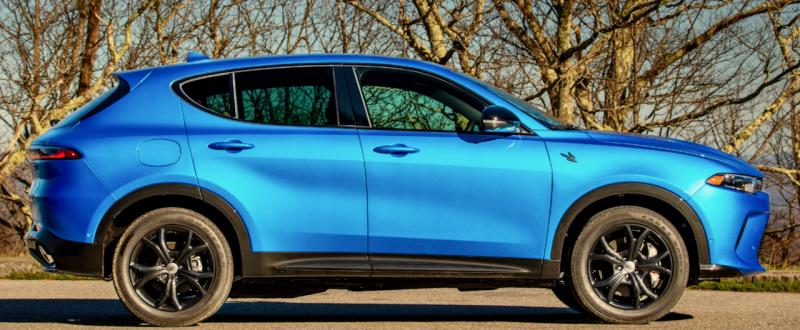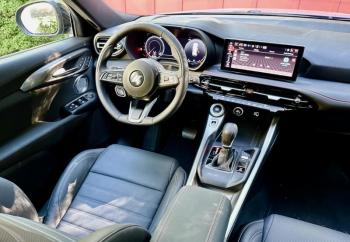Dodge Hornet GT Plus Blacktop AWD
The buzz around the Dodge Hornet is aimed at young couples with an “active” lifestyle who haul a dog, camping gear and a couple of mountain bikes, but who do not want a Subaru. The male half of the couple may be impressed by the Hornet’s one party trick, and perhaps its Italian roots; both owners should be pleased by the long list of standard and available features.
The Hornet marks Dodge’s return to the compact-crossover-SUV market; it arrived a year ago as a 2023 model, and our ’24 is basically unchanged. However, unlike its predecessor, the sad little Caliber, which was a Jeep Compass underneath its sheet metal, the Hornet is based on—wait for it—an Alfa Romeo! This likely means squat to Generation Zed, born between 1997 and 2012, but many older drivers still revere the Alfa brand. (Younger ones too, if they saw Adam Driver as Enzo Ferrari in last year’s film.)
I am one of those older drivers, but I must add that the only recent Alfa that curled my remnant hair was the stunning two-seat 4C, which was with us from 2013 to 2020. The Hornet’s donor Alfa, the Tonale compact crossover, is likeable enough, but, as I wrote about the Tonale Veloce EAWD, “Top speed, response, handling, braking . . . nothing stands out, nothing shouts I am an Alfa Romeo!” The Hornet GT doesn’t shout I am a Dodge! either—if we think of the Chargers, Challengers, Daytonas, Hellcats and the like that made Dodge famous, or notorious.
Our Hornet GT Plus packs a so-called Hurricane4 engine, a 2.0-litre turbocharged Four tuned to 268 horsepower and 295 lb-ft of torque. Its party trick is the PowerShot feature, a button on the steering wheel that adds a 15-second burst of 30 more horsepower. Even with all-wheel drive, this can elicit a brief squeal from the front tires; the novelty wears off quickly. Sport mode alters the shift points in the 9-speed automatic transmission and tightens the steering and the limited-slip differential. Available adjustable Koni shock absorbers, Brembo brakes and 20-inch performance wheels and tires round out the performance package.
The Hornet GT can be hustled along a winding road with illegal pace, and standing on the throttle produces surprising acceleration, but nothing in its everyday demeanor suggests this hot-hatch capability. Much more evident are the digital doodads that younger drivers depend upon. The 12.3-inch driver’s screen and the 10.25-inch main screen add up to 22.55 inches of computer display, which can be configured to the owner’s desires via Dodge’s Uconnect system.
Navigation and wireless Android Auto and CarPlay are included; Alexa is on board, plus a wireless charger and connections for two phones. The Harman Kardon stereo pumps 465 watts of sound through a subwoofer and 14 speakers. The expected active safety systems are here also, from automatic emergency braking with pedestrian and cyclist detection to blind-spot and parking monitors; our Hornet has adaptive cruise control with lane centering, too.
The $1,995 Blacktop Package adds ventilated and heated black leather seats, black wheels, black mirrors . . . lots of black trim, which instead of looking mildly sinister (if that was the intent) comes across as merely dour.
Upon its debut as a 2023 model, Dodge touted the Hornet GT as the “quickest, fastest, most powerful utility vehicle under $30,000.” But our example, a 2024 all-wheel drive Blacktop GT Plus, lists for $40,485—and there’s another five grand or so of add-ons still available. In March 2020, the average new-car price in the US was around $35,000; now it’s more than $47,000. By today’s metric, then, the Hornet’s MSRP is acceptable even in its younger-driver niche. But if you’re still in a pre-pandemic-inflation mindset, you too may think this car “feels” like it should cost less—but then I still “feel” like I should be able to check out at the supermarket for less than $100.
Next week: Mazda CX-30 AWD


































